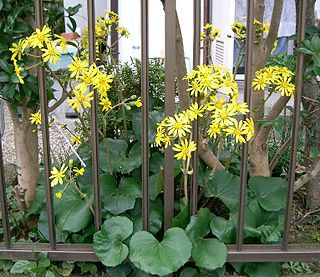
Senecioneae is the largest tribe of the Asteraceae, or the sunflower family, comprising over 150 genera and over 3,500 species. Almost one-third of the species in this tribe are placed in the genus Senecio. Its members exhibit probably the widest possible range of form to be found in the entire plant kingdom, and include annuals, minute creeping alpines, herbaceous and evergreen perennials, shrubs, climbers, succulents, trees, and semi-aquatic plants.
Harold Ernest Robinson was an American botanist and entomologist.
Jalcophila is a genus of flowering plants in the family Asteraceae.

Rune Bertil Nordenstam is a Swedish botanist and professor emeritus at the Swedish Museum of Natural History in the Department of Phanerogamic Botany. He has worked with Colchicaceae, Senecioneae and Calenduleae, was the editor of Compositae Newsletter newsletter since 1990, and is a Tribal Coordinator for The International Compositae Alliance with responsibility for the tribes Calenduleae and Senecioneae.

Pieter B. Pelser is a lecturer in Plant Systematics and the curator of the herbarium at the University of Canterbury in Christchurch, New Zealand. One research interest is the evolutionary history of the tribe Senecioneae, one of the largest tribes in the largest family of flowering plants. He wrote the most recent attempt to define and delimit this tribe and its problematic founding species Senecio. He also studies insects that eat these plants (Longitarsus) which contain pyrrolizidine alkaloids and what makes them choose which plants they eat.

Caucasalia is a genus of flowering plants in the daisy family.

Chersodoma is a genus of South American flowering plants in the daisy family. Members of this genus or dioecious shrubs or subshrubs.
Cissampelopsis is a genus of flowering plants in the daisy family, native to India, China, and Southeast Asia.

Dolichoglottis is a genus of flowering plants in the daisy family, Asteraceae.

Farfugium is a genus of flowering plants in the family Asteraceae, native to streams and seashores in east Asia. They are rhizomatous evergreen perennials with rounded leathery leaves and bright yellow flowers in autumn and winter. Species include Farfugium japonicum, with variegated cultivars for use in horticulture.

Hasteola is a genus of flowering plants in the daisy family, Asteraceae.

Homogyne is a genus of flowering plants in the daisy family, Asteraceae.

Lasiocephalus is a genus of South American flowering plants in groundsel tribe within the sunflower family. The genus was shown to be part of Senecio and predominantly occurs in tropical alpine-like regions.
Paracalia is a genus of South American flowering plants in the groundsel tribe within the sunflower family.

Parasenecio is a genus of flowering plants in the tribe Senecioneae within the family Asteraceae. Most of the species are Asian, but one (P. auriculatus) occurs in the Aleutian Islands in Alaska.

Rainiera is a monotypic genus of flowering plants in the daisy family, Asteraceae. The single species, Rainiera stricta(Greene) Greene, is endemic to the northwestern United States. The genus is part of the tribe Senecioneae, and appears to be most closely related to Luina, another genus of northwestern North America, in which it was once placed. Rainiera stricta is of conservation concern, with a G2G3 ranking from NatureServe, and is considered to be globally imperiled. It is known by the common name false silverback.
Luciliocline is a genus of flowering plants in the pussy's-toes tribe with the daisy family.
Mniodes is a genus of South American flowering plants in the tribe Gnaphalieae within the family Asteraceae.
Plazia is a genus of South American plants in the family Asteraceae.
Chrysactinium is a genus of South American flowering plants in the family Asteraceae.











